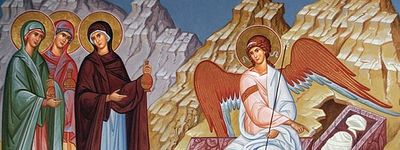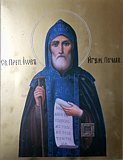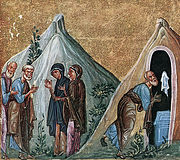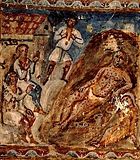

| Previous day | Next day |
| Old Style
May 6
|
Sunday |
New Style
May 19
|
| 3rd Sunday of Pascha. Sunday of the Myrrh-bearing Women. Tone 2. | No fast.
|
![]() Righteous Job the Long-suffering (ca. 2000-1500 b.c.).
Righteous Job the Long-suffering (ca. 2000-1500 b.c.). ![]() Sunday of the Myrrh-bearing Women: Mary Magdalen; Mary, the wife of Cleopas; Joanna; Salome, the mother of the sons of Zebedee; Susanna; Mary and Martha, the sisters of Lazarus; Mary, Mother of Apostle James. Righteous Joseph of Arimathea and Nicodemus.
Sunday of the Myrrh-bearing Women: Mary Magdalen; Mary, the wife of Cleopas; Joanna; Salome, the mother of the sons of Zebedee; Susanna; Mary and Martha, the sisters of Lazarus; Mary, Mother of Apostle James. Righteous Joseph of Arimathea and Nicodemus.
Martyrs Barbarus the Soldier, Bacchus, Callimachus, and Dionysius, in Morea (ca. 362). ![]() St. Tamara, queen of Georgia (13th c.). St. Micah, disciple of St. Sergius of Radonezh (1385). St. Job, abbot and wonderworker of Pochaev (1651).
St. Tamara, queen of Georgia (13th c.). St. Micah, disciple of St. Sergius of Radonezh (1385). St. Job, abbot and wonderworker of Pochaev (1651).
St. Edbert, bishop of Lindisfarne (698). Translation of the relics of St. Sava I of Serbia (1238). Venerable Sinaites of Serbia: Romilus of Ravanica, Romanus of Djunisa, Sisoes of Sinai and Sisojevac, Martyrius of Rukumije, Gregory of Gornjak, Zosimas of Tuman, and Gregory of Sinai (Mt. Athos) (14th c.). St. Seraphim of Mt. Dombos (1602). Translation of the relics of St. Pachomius of Nerekhta (1675). Martyrs Cyria, Caleria [Valeria], and Marcia, of Caesarea in Palestine (304). All Saints of Thessalonica: New Hieromartyr Seraphim, archbishop of Phanarion and Neochorion (1601). New Monk-martyr Elias (Ardunis) of Mt. Athos and Kalamata (1686). New Martyr Demetrius of the Peloponnese, at Tripolis (1803).
Repose of Archbishop Theophylactus (Lopatinsky) of Tver and Kashin, theologian and defender of Orthodoxy (1741), and slaying of Priest John Karastamatis of Santa Cruz (1985).
Thoughts for Each Day of the Year
According to the Daily Church Readings from the Word of God
By St. Theophan the Recluse

Sunday of the Myrrh-Bearing Women. [Acts 6:1–7; Mark 15:43–16:8]
The tireless women! They would not give sleep to their eyes nor slumber to their eyelids (cf. Ps. 132) until they found their Beloved! But the men as if dragged their feet: they went to the tomb, saw it empty, and remained in confusion about what it could mean because they did not see Him. But does this mean that they had less love than the women? No, here was a reasoning love which feared making a mistake due to the high price of this love and its object. When they too saw and touched Him, then each of them, not with his tongue, like Thomas, but with his heart confessed: my Lord and my God (John 20:28), and already nothing could separate them from the Lord. The myrrh-bearers and the Apostles are an image of the two sides of our life: feeling and reasoning. Without feeling life is not life; without reasoning life is blind, offers little sound fruit and much is wasted. We must combine both. Let feeling go forward and arouse; let reason determine the time, place, method and generally the practical arrangement of what the heart suggests for us to do. Within, the heart comes first, but in practical application, reason comes first. When the feelings become educated in discerning good and evil, then perhaps it will be possible to rely on the heart alone. Just as shoots, flowers and fruits grow naturally from a living tree, so does goodness alone emerge from the heart, rationally mingling into the course our life.
Articles
 St. Job of Pochaev |
 Sunday of the Myrrh-bearing Women |











